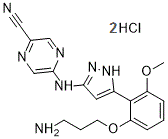Immunoblotting and RT-PCR analyses revealed that knockdown of CD133 resulted in a decrease in the levels of desmoglein-2 protein, but not desmoglein-2 mRNA, a result that was confirmed by immunohistochemistry. Knockdown of CD133 using a distinct shRNA also resulted in downregulation of desmoglein-2. Similar results were obtained with the human intestinal epithelial cell line Caco-2, which also expresses high levels of CD133. In addition, knockdown of CD133 led to a slightly diffused localization of plakoglobin. Furthermore, we  found that knockdown of plakoglobin resulted in a decrease in the levels of desmoglein-2 protein. Consistent with these results, hanging drop cell aggregation assays revealed that knockdown of desmoglein-2 resulted in a decrease in adhesion of CCC cells. These results suggest that CD133 is required for the stability and proper localization of desmosomal proteins. CD133 is widely used to isolate a variety of cancer stem cells, including CCC of the ovary. However, its functional contribution to tumorigenesis has been unclear. Cell-cell adhesion is an inherent characteristic of solid tumors, and several reports have suggested that desmoglein-2 is essential for the tumorigenicity of several epithelial tumors. Thus, we examined the potential role of CD133 in the tumorigenicity of CCC stem cells using an shRNA-encoding lentivirus to stably knockdown CD133 expression. Soft-agar colony-forming assays revealed that knockdown of CD133 resulted in a decrease in the colony-forming ability of CCC stem cells. In addition, knockdown of desmoglein-2 also reduced colony formation. When the CD133-knockdown cells were subcutaneously injected into immunocompromised mice, they grew at a significantly reduced rate compared to the control cells. This result suggests that CD133 is required for the tumorigenicity of CCC stem cells. In this report, we demonstrated that CD133 interacts with plakoglobin and controls cell-cell adhesion in CCC stem cells. Of particular interest is the fact that knockdown of CD133 in CCC stem cells caused a reduction in the levels of desmoglein-2. The mechanism by which the CD133-plakoglobin complex stabilizes desmoglein-2 remains to be investigated. In hematopoietic stem cells, CD133 is known to be enriched at the sites of contact with osteoblasts. Thus, CD133 may function in both cancer and normal stem cells as a regulator of cell-cell interactions. We further showed that CD133 is important for the tumorigenicity of CCC stem cells. This finding is consistent with previous reports showing that desmoglein-2 is involved in tumorigenesis. It is therefore intriguing to speculate that CD133 and/or desmoglein-2 may be therapeutic targets for CD133-positive epithelial cancer stem cells. Although it is well accepted that both genetic and environmental factors are likely to trigger the pathogenic pathways of AD, researchers over the last decade have mainly focused on studying the genetic contributions in AD. Studies have recently begun to investigate the effect of environmental factors on neuropathology and cognitive function in transgenic models of AD. In contrast to the clinical observations that environmental factors play important roles in the complex etiology of AD, contradicting findings from animal models of AD have been reported. For example, environmental enrichment, such as increased physical activity, cognitive stimulation, or a combination of both, has been demonstrated to elicit different outcomes.
found that knockdown of plakoglobin resulted in a decrease in the levels of desmoglein-2 protein. Consistent with these results, hanging drop cell aggregation assays revealed that knockdown of desmoglein-2 resulted in a decrease in adhesion of CCC cells. These results suggest that CD133 is required for the stability and proper localization of desmosomal proteins. CD133 is widely used to isolate a variety of cancer stem cells, including CCC of the ovary. However, its functional contribution to tumorigenesis has been unclear. Cell-cell adhesion is an inherent characteristic of solid tumors, and several reports have suggested that desmoglein-2 is essential for the tumorigenicity of several epithelial tumors. Thus, we examined the potential role of CD133 in the tumorigenicity of CCC stem cells using an shRNA-encoding lentivirus to stably knockdown CD133 expression. Soft-agar colony-forming assays revealed that knockdown of CD133 resulted in a decrease in the colony-forming ability of CCC stem cells. In addition, knockdown of desmoglein-2 also reduced colony formation. When the CD133-knockdown cells were subcutaneously injected into immunocompromised mice, they grew at a significantly reduced rate compared to the control cells. This result suggests that CD133 is required for the tumorigenicity of CCC stem cells. In this report, we demonstrated that CD133 interacts with plakoglobin and controls cell-cell adhesion in CCC stem cells. Of particular interest is the fact that knockdown of CD133 in CCC stem cells caused a reduction in the levels of desmoglein-2. The mechanism by which the CD133-plakoglobin complex stabilizes desmoglein-2 remains to be investigated. In hematopoietic stem cells, CD133 is known to be enriched at the sites of contact with osteoblasts. Thus, CD133 may function in both cancer and normal stem cells as a regulator of cell-cell interactions. We further showed that CD133 is important for the tumorigenicity of CCC stem cells. This finding is consistent with previous reports showing that desmoglein-2 is involved in tumorigenesis. It is therefore intriguing to speculate that CD133 and/or desmoglein-2 may be therapeutic targets for CD133-positive epithelial cancer stem cells. Although it is well accepted that both genetic and environmental factors are likely to trigger the pathogenic pathways of AD, researchers over the last decade have mainly focused on studying the genetic contributions in AD. Studies have recently begun to investigate the effect of environmental factors on neuropathology and cognitive function in transgenic models of AD. In contrast to the clinical observations that environmental factors play important roles in the complex etiology of AD, contradicting findings from animal models of AD have been reported. For example, environmental enrichment, such as increased physical activity, cognitive stimulation, or a combination of both, has been demonstrated to elicit different outcomes.
Do you recognize the facts on Low impulsive patients in particular showed a lowered heart rate under ATD while behaving aggressively? We really did not either till we created this short article over at http://www.clinicallysmallmolecule.com/index.php/2019/02/23/case-livestock-species-embryonic-stem-cell-line-germ-line-characteristic/